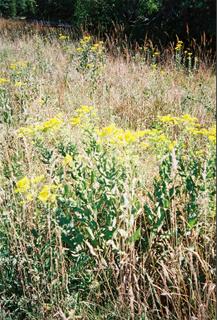 |
| Saint John the Baptist Catholic Church in St. John, Wisconsin |
My "German" ancestors did not think of themselves as people who came from Germany - because at the time they arrived in Wisconsin, there was no land called Germany. They were Germanic peoples who called themselves Bavarians, Prussians from the Rhineland, and Egerlanders (German Bohemians from the Austrian Empire). Somehow, they all converged in two townships in tiny Calumet County and became "Wisconsinites."
In the 1860s, the Rhinelanders who had been ruled by Prussia settled in a small area of Woodville Township in Calumet County. It was heavily wooded, with mostly uncleared land. The "125th Aniversary of St. John the Baptist Congregation, St. John Wisconsin," refers to the township as one of the most fertile farming districts that can be found in the State of Wisconsin.
While he is almost unknown in any of the histories of the Town of Woodville or in the list of immigrants from the tiny village of Irish One of the first Irsch settlers in the Town of Woodville, Calumet County, Wisconsin was Philip Thomas. His name and the names of his wife and children, appear in the 1860 Census of the United States. He was the brother-in-law of Heinrich Britten who, along with my ancestor and several other families from Irsch, set out for the Town of Woodville by way of the Port of Le Havre in March of 1861. Very possibly, he had written one of the famous "America Letters" which urged German countrymen to come to the new world.
There was also a little pamphlet called "Wisconsin: What it Offers to the Immigrant." published in English and German by the State Board of Imimigration of Wisconsin, along with another called "Wisconsin: Bevölkerung, Bodenbeschaffenheit und Klima im Norden Wisconsin." (The Population, Soil Condition and Climate of Northern Wisconsin). Both were distributed by the Wisconsin Office of Emigration from 1852-1855.
Over the next 15 years, an American version of a very small German village formed and called itself St. John, in honor of St. John the Baptist. Possibly it was letters written by Philip Thomas to Heinrich Britten that brought about this "little Irsch."
The same thing was happening all over Wisconsin. Settlers from the Rhineland villages of Zerf and Oberzerf, in the 1850s made their way to rich farm land west of Madison to a near a town appropriately called "Black Earth." Matthias Rauls of Oberzerf was one of them; his sister and my great grandmother, Magdalena Rauls, settled in St. John with her husband John Meier who came from Irsch.
The first concern for the settlers who arrived in 1861 was shelter, then clearing and planting some land, enough to see them through the winter. But by 1862, they were feeling the need for a Catholic parish. On November 24, 1862, four acres of land had been donated for the building of a log church, a mission church which was serviced by the various pastors of St. Francis Church of Hollandtown, Wisconsin.
Settlers, including many more from Irsch, continued to arrive and purchase land in the Township and by about 1865, the log church was too small to accomodate all of the Catholic population in the area. A frame church was constructed and named St. John the Baptist when it was blessed and dedicated by Bishop Henni, who later became the first Archbishop of Milwaukee.
Five years later, still not satisfied with their church, which was the heart of the village now called St. John, the brick church, remodeled a little but still standing, was built at a cost of $6,545.
Sources:
125th Anniversary of St. John The Baptist Congregation, St. John Wisconsin, 1862-1987
State Historical Society of Wisconsin. Germans in Wisconsin by Richard H. Zeitlin, 1977



